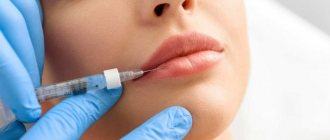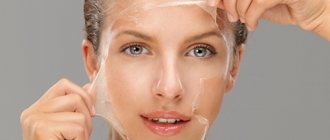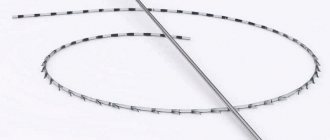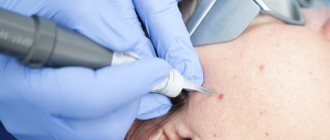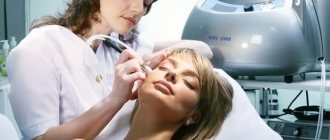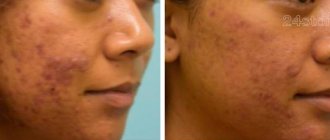- What is carboxytherapy
- Story
- Properties of CO2 in the body
- Mechanism of action
- Kinds
- Indications
- Contraindications
- Execution technique
- Device requirements
- The phenomena of “gas” beauty injections
- Recommendations
- How long does the course last?
- For what age
- Combination with procedures
- Clinical examples
- Pros of carboxytherapy
- conclusions
Carbon dioxide is the basis of all life on Earth and a necessary component of metabolic processes in the body.
Over time, the supply of oxygen to tissues, which is closely related to carbon dioxide, deteriorates, and metabolic disorders occur. To solve problems of general and local healing, carboxytherapy has been used for many centuries, which has proven itself in therapy and aesthetic medicine. The technique is a non-surgical and effective way to naturally restore cellular resources, which combines the interaction of mechanical, chemical and temperature factors to preserve beauty and health.
Story
460-370 BC, Ancient Greece - Hippocrates prescribed baths in carbon dioxide springs and dosed drinking to treat dermatological lesions.
1777 - Becher explained the positive effects of gas on the body.
XVII-XVIII centuries. - Robert Boyle, Antoine Lavoisier established the bactericidal properties of carbon dioxide.
1932 - the first introduction of carbon dioxide at a balneological resort for the treatment of joint and cardiovascular diseases.
1995 - The beginning of the aesthetic use of carbon dioxide.
2006 - creation of a separate course on cosmetological carboxytherapy at the University of Siena.
Indications for gas injections
Like any medical procedure, gas injections in Karlovy Vary have indications and contraindications. Pneumoacupuncture helps to achieve maximum therapeutic effect in the fight against both diseases and aesthetic defects:
- Joint diseases caused by degenerative transformations (osteochondrosis, arthritis, intervertebral hernia, gout, etc.).
- Pathologies of the cardiovascular system.
- Chronic pain of various etiologies.
- Gastrointestinal diseases.
- Muscle disorders (myositis, atrophy, etc.).
- Reproductive system dysfunctions in women and men.
- Recovery after particularly serious pathologies (stroke, heart attack, atherosclerosis, etc.).
- Vein diseases.
- Overweight, cellulite.
- Aesthetic defects (scars, scars, wrinkles, swelling, etc.).
- Alopecia (baldness).
Today, carbon dioxide is successfully used in cosmetology and medical institutions in Europe and Russia, but the palm belongs to Karlovy Vary, where they first learned what it is - treatment with gas injections.
Properties of CO2 in the body
- Carbon dioxide is a colorless gas with two oxygen atoms and one carbon atom, odorless, one and a half times heavier than air.
- It is a normal component of the atmosphere, where it is detected in minimal quantities in the air, and in sufficient quantities in mineral water.
- It appears as the end product of biological processes: respiration, fermentation or as a result of the combustion of coal fuel.
- It has increased solubility compared to oxygen.
- Produced by cells, maintains acid-base balance and affects protein formation, cell membrane permeability, hormone synthesis and the state of the nervous, hematopoietic, and excretory systems.
- The body contains 7% CO2, which is produced in the amount of 1 kg per day and is an internal product of metabolic processes.
- It is also found in a dissolved state in blood cells - erythrocytes in the form of carbonic acid salts.
- It is distributed through the venous system and exhaled by the lungs, where the concentration of the component decreases while controlling the body's defenses.
- It is interconnected as a result of transport by hemoglobin with oxygen, with which it is in a 3:1 ratio, which creates normal conditions for the life of the body.
- When used medically, it is absorbed into the body and eliminated after 30 minutes, therefore it is absolutely and naturally safe.
Effect of the procedure
Doctors and patients notice positive changes after carboxytherapy sessions:
- Blood circulation increases in the affected areas.
- Swelling disappears, the pressure of the vertebrae on the nerve endings decreases.
- Cerebral circulation disorders and dizziness weaken or disappear.
- The outflow of lymphatic fluid improves.
- The functionality of the damaged segments of the spine is restored.
- The risk of further development of vertebral or joint pathologies is reduced.
- The activity of the spinal cord is restored.
- The cartilage layer is saturated with nutrients, and the regeneration of damaged tissue is accelerated.
- Spasms disappear, as well as pain in muscles and ligaments.
- The inflammatory process is reduced.
- Signs of meteopathy (meteosensitivity) are relieved.
- Headaches caused by diseases of the cervical spine disappear.
- The functioning of the nervous system improves and sleep improves.
- Venous blood flow is restored.
- The breakdown of fats accelerates.
- Metabolic processes are stimulated, the body is cleansed of waste and toxins.
- The body begins to produce collagen.
- The body's defenses are strengthened.
As you can see, carboxytherapy is beneficial not only for joints, but also for the whole body.
Reference. Gas injections demonstrate anti-inflammatory, analgesic, antimicrobial, rejuvenating, and restorative effects.
During the procedure, no chemicals are used that can irritate tissues. As reviews say, pneumopuncture is safe and effective, and the result can be seen after the first injection. 1 session lasts no longer than 5 – 10 minutes.
After carboxytherapy, the patient can immediately return to normal activities. If the patient follows the doctor’s recommendations, then the likelihood of side effects is zero. At the end of the session, painful sensations in all parts of the spinal column weaken or disappear.
Mechanism of action
- When carbon dioxide is supplied under pressure, unstable carbonic acid dissociates into ions after combining the substance with water, which leads to a decrease in pH, lipid oxidation, and activation of lymph and blood circulation.
- With the tissue distribution of carbon dioxide, capillaries expand, artificial signaling systems of “oxygen starvation” are activated, and local temperature increases, which improves trophism and general immunity.
- CO2 is a strong vasodilator that regulates blood flow and relaxes muscle cells. Normally, the partial pressure of carbon dioxide in the blood is 40 mmHg. When it increases, the flow of oxygen increases and microcirculation is stimulated.
- The substance saturates tissues with oxygen, which enhances regeneration, recovery and provides antispasmodic and analgesic effects.
- An increase in gas exchange promotes the release of oxygen from hemoglobin, its active entry into tissues and the activation of energy resources - the Verigo-Bohr effect.
What is it used for?
The role of gas injections in the treatment of the musculoskeletal system is great. So, they help cope with:
- arthritis and arthrosis;
- inflammation and dystrophic changes in ligaments;
- rheumatism;
- degenerative destruction of intervertebral discs, including osteochondrosis, as well as protrusion or hernia;
- vestibular disorders;
- regular pain symptoms in the back and joints.
In addition, gas injections are used in neurology. For example, in the treatment of migraines, varicose veins, even in urology and gynecology.
Moreover, a stunning effect of gas injections in the beauty industry has been revealed - in the fight against cellulite, as well as in non-surgical skin tightening and improving its tone. That is, carboxytherapy is practically a replacement for Botox!
Among other things, injections with carbon dioxide improve blood circulation, help regenerate tissue and remove toxins and waste from the body, break down fats and, most importantly, have no side effects!
Kinds
Non-invasive carboxytherapy is a transdermal method of saturating the skin with carbon dioxide using special means - a mask with the main component - a carbon dioxide molecule and additional substances: hyaluronic, fruit acids, vitamins, plant extracts to increase nutrition and hydration of cells. The technique does not damage the barrier functions of the skin and does not injure soft tissues. It is rarely used, as it has a low speed of manifestation of the result and a small severity of the impact.
Invasive carboxytherapy is the intra- and subcutaneous injection of carbon dioxide using a special device with thin needles for renewing and rejuvenating effects. Manipulation is popular as it provides long-lasting healing results and rapid delivery of gas to the points of influence.
Contraindications to gas injections
Like any medical procedure, carboxytherapy has a number of limitations. It cannot be carried out in such conditions as:
- Acute infection.
- Exacerbation of dermatological problems.
- Pregnancy, breastfeeding.
- Acute form of heart failure.
- Epilepsy.
- Open wounds and injuries (including gangrene).
- Kidney failure.
In general, injections of carbon dioxide are harmless, because this substance is involved in natural metabolic processes.
Indications
- Prevention of premature age-related changes.
- Chrono-, photoaging with signs of wilting, wrinkles, decreased elasticity.
- Oily, porous skin with acne and post-acne manifestations.
- Correction of the periorbital zone: “bags”, “dark circles” under the eyes, drooping upper eyelids, “crow’s feet”.
- Folds in the neckline, upper lip - “purse-string wrinkles”, neck - “rings of Venus”.
- Dry, thin, flabby skin of the face, body, back of the hands.
- Hyperpigmentation and uneven color of the epidermis.
- Local pastosity, atonicity and swelling of tissues.
- Pronounced “vascular pattern” and telangiectasia.
- Subcutaneous accumulations of fat in the submental area - a “double” chin.
- Lipomatosis is a limited proliferation of lipid tissue.
- Cellulite and local fat deposits in the abdomen, thighs, buttocks, upper and lower extremities.
- Stretch marks - stretch marks, scars, including keloids.
- Restoring shape after childbirth, sudden weight loss.
- Hair loss, dullness.
- Skin dermatoses - psoriasis, eczema.
- Trophic ulcers and difficult-to-heal wounds as part of complex therapy.
- Preparation or rehabilitation before and after plastic surgery, liposuction, burns, injuries.
- Treatment of medical diseases in various fields: neurology, cardiology, endocrinology, traumatology.
Contraindications
- Pregnancy, lactation.
- Viral and infectious processes: pustular lesions, herpes.
- Increased body temperature.
- Severe damage to the cardiovascular and respiratory systems.
- Chronic renal and liver failure.
- Severe abdominal obesity - with a BMI over 30.
- Blood clotting disorders and taking anticoagulants, antiplatelet agents.
- Malignant and multiple benign neoplasms.
- Acute thrombophlebitis, phlebothrombosis.
- Epilepsy.
- Tuberculosis.
- Individual intolerance.
Precautionary measures
Carbon dioxide is quickly eliminated from the body, so it does not cause any particular harm to the body. However, some restrictions still exist:
- Post-infarction or post-stroke condition. Due to the acceleration of blood flow, there is a risk of increasing the area of damage in the heart muscle.
- Epileptic seizures, mental disorders. A seizure may occur after the injection.
- Angina pectoris (a form of myocardial ischemia, which is accompanied by chest pain).
- Functional failure of the heart, kidneys or lungs.
- Liver diseases.
- Severe form of hypertension. Due to vascular spasm, a hypertensive crisis or stroke may develop.
- Severe inflammatory processes of tissues or organs. There is a possibility of infection of the area at the injection site and intensification of the pathological process.
- Period of pregnancy, lactation. There is no evidence that the procedure is safe for the child.
- Blood clotting disorder.
- Simultaneous use of diuretics from the group of carbonic anhydrase inhibitors and anticoagulants. Nasal and menstrual hemorrhages may increase.
An allergic reaction to gas injections is impossible, this is due to the fact that CO² is a natural gas that is produced in the body. The risk of infection is also minimal, since sterile instruments and purified gas are used during the procedure.
Execution technique
A non-invasive method is a way to quickly improve facial health, which is carried out in a salon or at home, following the following steps.
- Makeup removal and toning.
- Application of light enzyme peeling.
- Distribution of a special conductive gel to open pores and penetrate active components.
- Apply a carbon dioxide and fabric mask for 15-30 minutes.
- Removal of the active mixture and treatment with serum and nourishing cream.
The injection method includes certain details:
- Consultation with a specialist, collection of anamnesis, identification of contraindications.
- Inspection of areas, selection of quantity, concentration and total dosage - no more than 1000 cm3.
- Cleansing and antiseptic treatment of areas of application with hydrogen peroxide.
- Connecting the device through a safety valve with attachments to alleviate pain and checking the foot pedal or handle for supplying the substance.
- Carrying out injections at a distance of 1-2 cm from each other using a disposable ultra-thin needle measuring 30-32 G using medical sterile carbon dioxide, which enters the diffuse gun from a metal cylinder through a pressure regulator with an indicator of 1 Bar - 0.1 MPa.
- The length of the needles is selected individually - for the face, neck, décolleté - 4-6 mm with an insertion angle of 15-30 degrees, for the body - 12-13 with a puncture angle of 30-45 degrees. After 8-10 injections the needle is changed.
- Injections are performed intra- or subcutaneously, with ante- or retrograde movements at a speed of 5-20 ml/min with precise control of carbon dioxide intake. To rejuvenate the epidermis and strengthen hair follicles, the insertion depth is 1-2 mm, to eliminate stretch marks - 5-6 mm, to treat cellulite - 3-10 mm.
- The procedure time is 20-40 minutes with a total volume of gas intake for the face - 5-50 ml, for the torso and limbs - 200-1000 ml.
- Assessing the patient’s subjective feelings, carrying out repeated disinfection and issuing recommendations after the procedure.
Stages of the procedure
First, the doctor conducts a diagnosis to identify all areas that need injections and identify contraindications. The specialist must have a certificate that allows him to conduct pneumopuncture sessions.
To ensure a positive result, injections are administered into the main areas of concentration of nerves and muscles around the affected joint or along the length of the spinal column. It is important to treat all areas suffering from hypoxia.
Progress of carboxytherapy:
- The patient puts on a hospital gown, sits on a chair or lies down on a couch.
- The areas where carbon dioxide is introduced are treated with an antiseptic solution to avoid infection.
- A small amount of carbon dioxide is taken into the tank of the diffuser gun, and a nozzle with a thin disposable needle is put on.
- Using the device, mini-injections are made that cause virtually no pain.
The depth of administration, appropriate pressure, and dose of CO² are selected by the doctor individually for each patient.
During the procedure, the patient may feel a slight burning sensation and crackling under the skin (this is how the gas is absorbed). After a few minutes, the discomfort disappears. If a person’s skin is sensitive, small bleeding wounds may appear that need to be covered with a band-aid.
If the patient has a phobia of injections, then he may ask to perform carboxytherapy under local anesthesia.
After gas injections, it is not recommended to rest; on the contrary, you need to take a walk or do simple physical exercises to speed up blood circulation. This way the effect of the procedure will be more pronounced.
Patients feel relief after the first session of gas injections
Relief occurs after the first procedure. The duration of the therapeutic course is from 3 to 10 sessions. The decision on the duration of the course is made by the doctor, and he takes into account age, general condition, and severity of the pathology. The effect after 1 course lasts for 12 months. To prevent exacerbation of the disease, the patient must undergo 1 additional session once every 4 weeks.
The phenomena of “gas” beauty injections
- Lifting, rejuvenating - stimulation of fibroblasts and the formation of new collagen fibers.
- Carbolipolytic - destruction of fat cell membranes and activation of local metabolism.
- Microcirculatory and remodeling - increasing blood flow and improving oxygen supply to tissues.
- Stimulating - synthesis of new vessels - neoangiogenesis.
- Vasodilator and nutritive - rapid distribution of carbon dioxide to nearby areas due to the good solubility effect and increasing gas exchange.
- Decongestant and renewing - accelerates lymphatic drainage and reduces venous stagnation.
- Antispasmodic and analgesic - the effect of reflex mechanisms on the intake of carbon dioxide.
- Protective - increasing local and natural protective functions.
- Antioxidant - release of excess fluid, waste and toxins.
- Regenerating and anti-inflammatory - activation of biological substances and restoration of trophism.
- Normalizing - restoration of skin hydrobalance and alignment of cellular structure.
Side effects
- Ripple, burning sensation, distension and tension at the injection site are natural reactions when carbon dioxide enters the tissue, last from 2 to 10 minutes and go away on their own after the procedure.
- Local swelling, a feeling of heat, redness and itching are expected manifestations due to increased blood circulation, and spontaneously disappear within 30-40 minutes.
- Subcutaneous crepitus-crackling is the result of deep influx of carbon dioxide, which lasts up to 20-30 minutes.
- Hematomas are a response mechanism to damage to the vascular wall during injection.
- Heaviness in the limbs occurs when carbon dioxide spreads in the cells and lasts up to 2 hours.
- Herpetic rashes occur with an incorrectly collected anamnesis and in the absence of rationally administered antiviral therapy.
Rehabilitation and precautions
There is practically no rehabilitation period required after gas injections. There is no need to stay in the hospital after the procedure. The only thing is that there are several restrictions that must be followed for several hours. At this time, it is forbidden to allow the body to become hypothermic, visit saunas or take steam baths.
You should not get the injection site wet; therefore, swimming and swimming in the pool are excluded. It is necessary to follow the precautionary rules for two days. Until the swelling at the injection site completely disappears.
Recommendations
With non-invasive carboxytherapy, a rehabilitation period is not required.
When injecting carbon dioxide, you must:
- do not wash your face or apply decorative cosmetics for 4-6 hours;
- for 12-24 hours do not sunbathe, do heavy physical exercise and do not visit the bathhouse, swimming pool, sauna;
- use healing agents if necessary (for example, Panthenol, Bepanten creams);
- Observe the drinking regime before and after the course, adhere to proper nutrition and a healthy lifestyle.
Course protocol
- Rejuvenation, lifting, hair growth restoration - 5-12 procedures 1-2 times a week.
- Cellulite and subcutaneous fat deposits - 1-3 procedures 21 days before surgical liposuction, then 10 days later for 2 months 2 times a week or 8-12 procedures 1-2 times every 7 days.
- Stretch marks, scars - 8-12 procedures once every 7-20 days.
- Maintenance course - once a month
- Repeat intensive treatment - 1-2 times a year.
What effect can you expect from dry carbon dioxide baths?
Many sanatoriums and health centers perform a procedure called a dry carbon dioxide bath. For many years, baths with carbon dioxide have been popular among doctors, as they provide a specific effect that is difficult to achieve by other methods.
Classic immersion baths and dry steam options make it possible to enrich the blood and internal tissues and organs with carbon dioxide, which is necessary for the normal functioning of the body.
How does a dry carbon dioxide bath affect the body?
A dry carbon dioxide bath is most often included in sanatorium programs for the treatment of cardiovascular diseases. Since immersion in water is not recommended for this pathology, procedures are carried out while sitting and dry.
Dry baths with carbon dioxide are also prescribed for hypertensive patients. Carbon dioxide in the form of steam perfectly dilates blood vessels and reduces blood pressure. After a course of procedures, the walls of blood vessels acquire elasticity and become stronger.
The effect of a dry carbon dioxide bath is beneficial for older people: the steam slows down the oxidative mechanisms in the body, and the body naturally slows down its aging. Carbon dioxide baths are very helpful for people who suffer from breathing problems. The gas cleanses the lungs and bronchi. Moreover, improvements are noticeable after the first session.
The beneficial properties of the procedure also include:
- activation and support of the immune system;
- increasing resistance to bacteria and viruses;
- improvement in the condition of the skin after weight loss;
- stimulation of skin cell regeneration, acceleration of wound healing;
- relaxation, relieving stress and fatigue.
Typically, carbon dioxide baths are prescribed in combination with other physiotherapeutic procedures. Carbon dioxide works well together with mud compresses and wraps, hydromassage, and contrast showers.
Tips for preparing for a dry carbon dioxide bath
A dry carbon dioxide bath is one of the procedures that do not require complex preparation of the body. No complicated or lengthy diets are required. You need to bring swimming trunks or a swimsuit with you for the procedure. The less clothing you wear on your body, the more powerful the effect of a carbon dioxide bath will be.
Most institutions offer a fresh water shower after the procedure. But this is optional. There is no salt or traces of foreign substances left on the body, so you can wait for your regular evening shower.
Preparation for a dry carbon dioxide bath depends on the time at which the procedure is scheduled. If it is morning, do not have breakfast so that the body undergoes treatment as comfortably as possible. It is better to eat after a bath an hour later. It is allowed to eat 2-3 hours before the procedure, so as not to experience heaviness in the stomach during the session.
After the bath, sit and relax for half an hour or an hour. Don't rush outside in winter. Most spas provide special rooms for such relaxation where you can drink hot herbal tea or fresh juices.
What effect can you expect from dry carbon dioxide baths?
The effect of a dry carbon dioxide bath occurs immediately. It is expressed in general stimulation of the body, raising tone. For this reason, carbon dioxide baths are usually prescribed in the first half of the day.
The full therapeutic effect depends on the nature of the disease:
- heart and blood vessels - improved well-being after 3-4 sessions;
- respiratory problems - 1-2 procedures;
- cellulite, excess weight - at least 12 procedures.
A dry carbon dioxide bath is prescribed in courses. If the disease is chronic and persistent, the patient can undergo several courses with a break of a month. The effectiveness of carbon dioxide treatment increases with accompanying factors:
- following a light diet (excluding fatty, sweet, spicy foods, increasing the diet of fresh vegetables and fruits);
- small systematic physical activity, gymnastics;
- increasing rest periods, normalizing emotional state, reducing stress factors and psycho-emotional stress.
It is important to watch for signs that the therapy is not right for you. This will be expressed through deterioration during or after sessions, severe tingling on the surface of the skin, changes in breathing rhythm, and rapid heartbeat.
* The information is for informational purposes only and is not a public offer as defined by the provisions of paragraph 2 of Article 437 of the Civil Code of the Russian Federation.
To obtain detailed information about the products sold, works, exact names and modifications and their prices, you must contact the sales managers of Fiziotekhnika LLC. Back
Combination with procedures
Non-injection and invasive carboxytherapy combine well with other cosmetic techniques.
- General hardware techniques - phonophoresis, electroporation, microcurrent therapy - to consolidate the result and enhance metabolism.
- Injection drugs - mesotherapy, plasma lifting, fillers, threads, Botox, lipolytics - for rehabilitation and enhancing the effect.
- Chemical peels, microdermabrasion - to stimulate cellular restructuring.
- Radiofrequency lifting, endermology, cryolipolysis, photo and laser rejuvenation - for prolonged action.
- Surgical methods - liposuction, blepharoplasty, circular facelift - for rehabilitation and tissue restoration.
Clinical examples
1. Patient, 32 years old. The skin is flabby, dehydrated, with wrinkles in the lower third of the face, forehead, and eyes.
An 8-week course of procedures was prescribed with an interval of 1 time per week with additional moisturizing and protective care.
Result: reducing the depth of wrinkles, improving the quality of the skin, increasing smoothness and tone.
2. Patient, 35 years old. Cellulite grade 2-3, decreased turgor.
15 combined sessions were prescribed: superficial and deep injections at intervals of 1-2 times a week, recommendations were given on proper nutrition and exercise.
Result: reduction of local fat deposits, smoothing of the epidermal relief, increase in elasticity.
Course of action
Before carrying out the manipulation, the specialist will necessarily perform a visual examination of the patient’s skin condition in order to fully understand the clinical picture of the pathology, as well as determine the presence of possible contraindications.
After this, a decision is made on a single dosage and the number of sessions required to eliminate a particular defect.
Then the skin fragments in the correction area are carefully treated with antiseptic drugs. Only after this does disincrustation begin - cosmetic cleaning of the skin by galvanization.
Initially, the tissues are steamed, then a thin layer of a special composition is applied to them, which will subsequently enhance the effects of carboxytherapy.
Pros of carboxytherapy
- Versatility - suitable for any skin type and age.
- All-season.
- Security and accessibility.
- Minimal invasiveness.
- Highly efficient and quick to act.
- Physiology and durability.
- Short recovery period.
- Selectivity and compatibility with many aesthetic procedures.
- Multifunctionality and wide range of applications.
Minuses
- Course and comprehensive methodology.
- Risk of secondary infection and individual intolerance.
- Ineffective for serious age-related changes.

